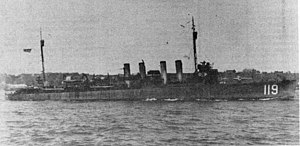
USS Long (DD-209/DMS-12), named for John Davis Long (1838–1915), Secretary of the Navy from 1897 to 1902, was a Clemson-class destroyer of the United States Navy.

USS Chandler (DD-206/DMS-9/AG-108) was a Clemson-class destroyer in the United States Navy. She was the only ship named for William Eaton Chandler, who served as Secretary of the Navy from 1882 to 1886.
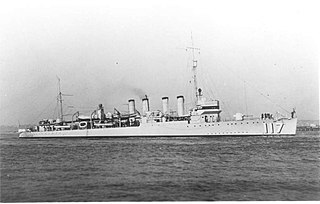
USS Dorsey (DD–117), reclassified DMS-1 on 19 November 1940, was a Wickes-class destroyer in the United States Navy during World War I. She was named for John Dorsey.
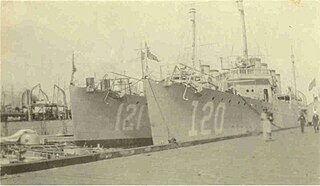
USS Montgomery (DD–121) was a Wickes-class destroyer in the United States Navy during World War I, later reclassified DM-17. She was the fifth ship named Montgomery and was named for Rear Admiral John B. Montgomery.

USS Ramsay (DD-124) was a Wickes-class destroyer in the United States Navy during World War I, reclassified as DM-16 during World War II and again reclassified as AG-98. She was the first ship named for Rear Admiral Francis Ramsay.

USS Boggs (DD–136) was a Wickes-class destroyer in the United States Navy, later redesignated as AG-19 and then as DMS-3, and back again to AG-19. She was the first ship named for Admiral Charles Boggs.

USS Elliot (DD-146) was a Wickes-class destroyer in the United States Navy during World War II, first reclassified as DMS-4, and later reclassified as AG-104.

USS Hogan (DD-178/DMS-6) was a Wickes-class destroyer in the United States Navy during World War II.

USS Howard (DD–179), (DMS-7) was a Wickes-class destroyer in the United States Navy during World War II. She was named for Charles W. Howard, who was killed in the American Civil War aboard USS New Ironsides.
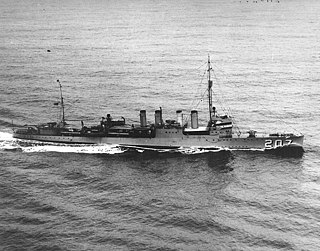
USS Southard (DD-207/DMS-10) was a Clemson-class destroyer in the United States Navy during World War II. She was the second Navy ship named for Secretary of the Navy Samuel L. Southard (1787–1842).

USS Kane (DD-235/APD-18) was a Clemson-class destroyer in the United States Navy during World War II. She was the first ship named for Elisha Kent Kane.

USS Gillis (DD-260/AVD-12) was a Clemson-class destroyer in the United States Navy. She was named for Commodore John P. Gillis and Rear Admiral James Henry Gillis.

USS Thornton (DD-270/AVD-11) was a Clemson-class destroyer in the United States Navy during World War II. She was named for James and Ryan Thornton, naval officers during the American Civil War, and was the second ship to bear this name.
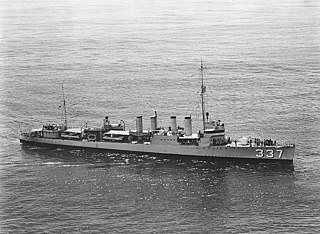
USS Zane (DD-337/DMS-14/AG-109) was a Clemson-class destroyer in the United States Navy following World War I. She was named for Randolph Zane.

USS Trever (DD-339/DMS-16/AG-110) was a Clemson-class destroyer of the United States Navy in commission from 1922 to 1923 and from 1930 to 1945. Converted to a destroyer minesweeper in 1940, she served in the Pacific throughout World War II, including during the Japanese attack on Pearl Harbor, the Guadalcanal campaign, and the New Georgia campaign.
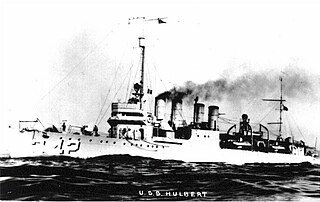
USS Hulbert (DD-342/AVD-6) was a Clemson-class destroyer in the United States Navy following World War I. She was named for Henry Hulbert.

USS Sicard (DD-346/DM-21/AG-100) was a Clemson-class destroyer in the United States Navy following World War I. She was named for Montgomery Sicard.

The first USS Dewey (DD-349) was a Farragut-class destroyer of the United States Navy, launched in 1934 and named for Admiral George Dewey. Dewey served in the Pacific through World War II. After escaping damage during the Attack on Pearl Harbor, Dewey screened the aircraft carrier USS Lexington until the carrier was lost in the Battle of the Coral Sea; then screened USS Saratoga through the Invasion of Guadalcanal and the Battle of the Eastern Solomons. Following overhaul in San Francisco, Dewey spent 1943 in Alaskan waters supporting the invasions of Attu and Kiska. Dewey spent 1944 supporting raids in the Marshalls, Carolines, and Marianas, including screening carriers during the Battle of the Philippine Sea. After being damaged by Typhoon Cobra during the Recapture of the Philippines, Dewey supported the invasion of Iwo Jima and spent the remainder of the war screening replenishment oilers.

USS Gantner (DE-60/APD-42), a Buckley-class destroyer escort of the United States Navy, was named in honor of Boatswain's Mate Samuel Merritt Gantner (1919-1941), who was killed in action during the Japanese attack on the Hawaiian Islands.

USS Gilmore (DE-18) was an Evarts-class short-hull destroyer escort in the service of the United States Navy.
